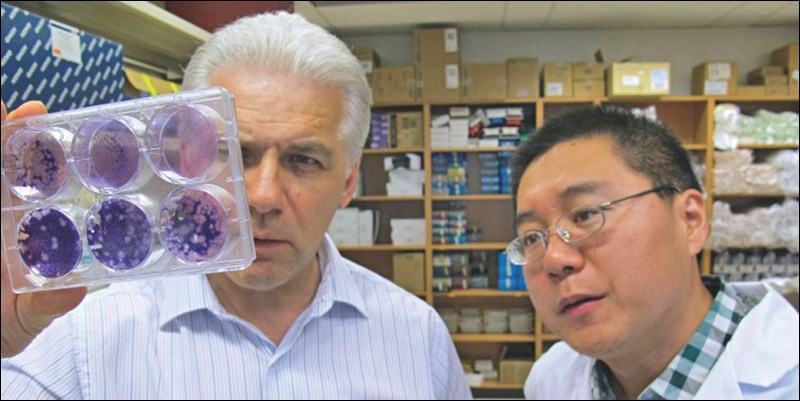Growing up in Snow Lake, Dr. Tom Hobman no doubt developed a local’s healthy distaste for mosquitoes… who knew he would someday be heading up a research team probing for a diagnostic test able to detect a virus carried by the pest.
Had he known, he likely would have swatted a few more of them back in the day.
Hobman, 54, is currently a professor of cell biology and associate dean research facilities in the Faculty of Medicine and Dentistry at the University of Alberta.
Those who were around in the 1970s will fondly remember him being part of “Team Rocket,” which had a membership of two: Hobman and Rick Robinson.
Together, these two kept their parents constantly on edge with the reality that whatever it was they were working on in the basement, it could in fact blow at any time!
It was growing up in Snow Lake where young Hobman first acquired and later refined a broad interest in science. One that took him from his 1979 Grade 12 graduation from Snow Lake School (JH Kerr) to a post-doctoral fellowship in cell biology at University of California San Diego.
Along the way, he also received a BSc in microbiology and MSc in human genetics at University of Manitoba, and a PhD in genetics at University of British Columbia.
“I have always been interested in science,” Hobman said of his youth. “It started in high school with homemade rockets and fuel. However, a rather violent explosion in my parents’ basement led us to pursue less dangerous areas of interest… such as working with disease-causing microorganisms – okay, maybe I didn’t think that through,” he joked.
Since that point, most of Dr. Hobman’s studies have revolved around understanding how pathogens, mostly viruses, interact with their hosts and why disease occurs.
Right now the doctor and his colleagues are focused on developing tools to study the Zika virus.
The US Centres for Disease Control and Prevention states that “Zika Virus Disease is a disease caused by Zika virus. First discovered in 1947, it is named after the Zika forest in Uganda and spread to people primarily through the bite of an infected Aedes species mosquito.
“The most common symptoms of Zika are fever, rash, joint pain and conjunctivitis (red eyes). The illness is usually mild with symptoms lasting for several days to a week after being bitten by an infected mosquito. People usually don’t get sick enough to go to the hospital, and they very rarely die of Zika.”
Since May 2015, the country of Brazil has suffered under a significant outbreak of Zika virus. Officials there have also noted an increase in the number of babies with congenital microcephaly (a birth defect in which the size of a baby’s head is smaller than expected for age and sex) during that time.
“While it was initially discovered [decades] ago, no one really cared about this pathogen until the link to microcephaly came to light,” said Hobman in relating his involvement with the virus. “As such, there is relatively little known about Zika virus and tools to study this virus are lacking. Some of the things we are doing include construction of infectious clones that can be modified for rapid drug screening… for antiviral therapies and animal models if necessary. We are also working with a number of other groups to develop rapid diagnostics for the virus. There is a tremendous amount of competition in the area, though.”
Hobman has been employed at the University of Alberta in Edmonton since 1994; his wife Marita is also employed there as assistant chair administration in the Department of Biochemistry. Their daughter Liv lives in Edmonton as well, where she manages a large boutique in Shoppers Drug Mart.
When he’s not immersed in his research, Dr. Hobman works at staying fit, and enjoys reading, wine collecting (and partaking in a bit of the collection), barbecuing and eating as much good food as possible.
“Anything worth doing… is worth doing to excess,” he jests.
When asked what, if any, influence growing up in Snow Lake had on the success he’s attained in his impressive career; the doctor doesn’t skip a beat and answers with the humour he is noted for.
“I have to thank my former teacher Keith Perron for encouraging Rick Robinson and I to ‘go legit’ with our science,” he said. “In all honesty, I think he was concerned that we would eventually blow ourselves up if we didn’t get out of the rocketry field. Mr. Perron encouraged Rick and I to pursue our biology projects and enter into the regional science fairs in northern Manitoba. We did that two years in a row and if memory serves me correctly, we won first overall both times. This allowed us to represent northern Manitoba at the national science fair and meet some amazingly bright kids from across Canada.”
He added that the people of Snow Lake were incredibly supportive of him and Robinson during that time and this played a significant role in Hobman’s decision to continue his studies in science at the post-secondary level.
“This may sound incredibly cliché, but even though I was not born in Snow Lake nor have I lived there for more than 30 years, when people ask me where I’m from… I always say, ‘I’m from Snow Lake.’”




